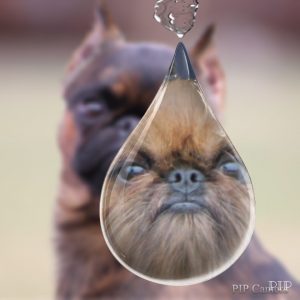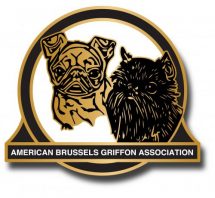
The Brussels Griffon may sport one of two coats, rough or smooth, but within these two categories one sees a wide range of variation in texture and quality. Looking first at the rough coat, one may find the extremely hard coat, or the “fluffy” softer coat, and the entire spectrum in between. It is unlikely that the dog that looks the flashiest in the ring, and is often rewarded by the all-round judge for the plush beard and furnishings that are appealing to his/her eye, has the proper coat, as it is rare to find ample beard and furnishings on an otherwise correctly coated rough. The Standard calls for a coat that is “wiry and dense, the harder and more wiry the better.” This correct coat challenges the owner/handler/groomer to grow beard and furnishings, and any number of methods have been devised and applied to promote the desired hirsutism, since these sparsely furnished but correct coats are many times penalized in the ring as being “out of condition” or not presenting a “typey” silhouette.
The extreme of the hard wiry coat is often called unnecessary to groom, or ungroomable, depending, it would seem, on regional and even international tradition. This rough coat appears to be more of a genetic confusion of rough and smooth, with the dog having a few short, very hard beard hairs and sparse or no furnishings. The nomenclature derives from the little or no hand-stripping necessary to keep these dogs in a neat jacket. Most often, this coat displays deep rich color in addition to texture, and appears in all four of the acceptable colors: black, red, belge, and black and tan.
On the other end of the spectrum of rough coats, is the soft, almost fluffy Wheaton-like coat. Many would say this is the true “ungroomable rough” as no amount of stripping and rolling can improve its texture and appearance. Stripping this outer coat, which most often appears in red or belge, reveals a proliferation of thick, usually silvery-white undercoat, or, more rarely on a black or black and tan, the undercoat appears as grayish fluff. Deep, rich color is usually lacking, but the soft texture of the hair allows for profuse beard and furnishings to be promoted. This coat is incorrect.
Envision this incorrect coat at the bottom of a ladder. As one climbs towards the ultimate coat, the topcoat becomes harder and the undercoat less prolific, but so do beard and furnishings. Usually color improves as well. About halfway up the ladder is the coat prized by handlers and exhibitors looking for their next “special.” It is hard enough for most judges, but soft enough to produce beard and furnishings to impress in the group ring. Color is of little concern – enhancers are everywhere.
Past this rung, and almost to the top, one encounters the correct rough coat. It has undercoat almost as hard as the topcoat, and often of the same color. It is unfortunate that this coat may be penalized in the ring as lacking in type or condition. Breeder-judges rarely make this mistake.
At first appearance, it would seem that there is little room for variation in a smooth coat, but on further investigation one finds different smooth coat textures as well. The smooth coat may be sleek, tight, and glossy, or be “fluffy” and stand away from the body. The former is correct. The smooth coat should resemble that of a Boston Terrier, with no undercoat, no appearance of a ruff around the neck, and no “pants” in the rear.
Further definition of the proper coats for both rough and smooth can be found in the new Illustrated Standard of the Brussels Griffon. The American Brussels Griffon Association also undertakes several breed seminars and judges seminars throughout the year where coats are discussed in detail and judges may have the opportunity for hands-on examination of the subtle (or not so subtle) differences.
Anne K. Catterson
17120 Cole Avenue
Riverside, Ca 92508
annecatt@gmail.com
Published in the March 2001 issue of the AKC Gazette
